A Comparison of Pole Bending Bases
by Ken SmithWe are frequently asked which pole bending bases are the best. We will share our opinion here, and explain why. There are also some models and gimmicks on the market that you should avoid. We do not sell bases, but we will tell you where you can get them.
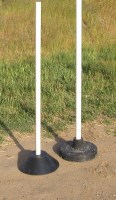
Selection Criteria
1) Association Approved.
There are several associations that have published specific rules regarding the poles and bases which are to be used in their approved events.
The bases we describe on this page are all approved by the AQHA (American Quarter Horse Association),
NPBA (National Pole Bending Association),
NHSRA (National High School Rodeo Association),
and NSCA (National Saddle Clubs Association - Omoksee).
Some associations use poles 5 feet in height, but most specify 6 feet. Here are some descriptions from the association rule books:
AQHA Rule Book: Poles shall be set on top of the ground, six feet (1.8 meters) in height, With no base more than 14 inches (35 cm) in diameter.
NPBA Rule Book: Poles shall be shall be set on top of the ground, 6 feet in height, and mounted in bases with a 14 inch diameter. Poles shall be PVC pipe, and bases shall be rubber or plastic. For added safety, PVC caps are recommended. Preferred color for poles is natural white, but red, white, and blue rings shall be allowed. Solid rubber bases are preferred, but hollow plastic bases shall be allowed only if filled completely to emulate a solid base. To illustrate, here is an example of a system that would comply with the preceding specification: Poles cut to 6 foot lengths from schedule 40 PVC, with glued-on rounded caps, mounted in hard rubber Josey bases.
2) Safety.
We have seen some really dangerous homemade bases over the years. Consider for example those made from the discs of a farm implement. We know of a horse that was crippled when he stepped on one of these bases that was lying on its side.
Then there are the gallon cans filled with cement. They tip way too easily, and can injure a horse if they strike one with a leg. Think about what might happen, and choose a safe option. You will need to spend at least a little money.
3) Ease of Use.
The poles need to be light enough to be easily handled by whoever will be setting up the patterns. And the poles need to be firmly held in place.
Have you seen those bases that come in a cloth bag, with take-down poles that screw together? Easy to use? We don't think so. After setting them up and tearing them down one time, most people just leave them set up - too much bother. And the bases require filling for stability. Try picking up a bag of six bases filled with sand! Why buy a bag to carry pole bases? Six solid bases will weigh close to 100 pounds! Who is going to cart that around? Poles are easiest to handle one at a time.
We have also seen ads for poles with a spring at the base that allows the pole to bend when hit and spring back upright, instead of tipping over. We think these would cause a horse and rider to become casual about hitting poles, and the ones being used in your next competition will not spring back! If you hit a pole in practice, it is a good thing to have to get off and stand that pole back up. It is an indication that you have some training to do - both of the horse and the rider.
4) Wind.
If your poles are going to be used outdoors and if you live in an area where you consistently have to ride in a lot of strong wind, then the heavier bases may be a better choice for you. Although we do not consider this a particular problem in our area, we have noticed that in our arena a strong wind will tip the lighter bases first, while the heavier bases are the last to go. Of course, some winds will flatten them all!
Here's a hint to help those of you who live in extremely windy areas: You might want to consider using the heavier bases, and in addition to a standard set of PVC poles, make up a second set with a PVC reducer and PVC pipe of one size smaller diameter. You will want to check with your association to see if you can use poles like these in competitions, but it would be a better solution than having to use sand bags on the bases to hold them up.
The Good and the Bad
All the best bases are made of molded hard solid rubber. You cannot go wrong with any of the three solid rubber models we describe below.
Avoid the screw-together poles. If hit at speed, the poles tend to shatter at the joints. We recently witnessed four of these broken in merely a half hour of competition.
We now consider the hollow plastic bases to be acceptable. We're referring to those that are designed to be filled with cement or sand. They can work fine, but you will have a frustrating experience unless you properly set them up. We will explain how to do that later in this article.O'Neil Bases.
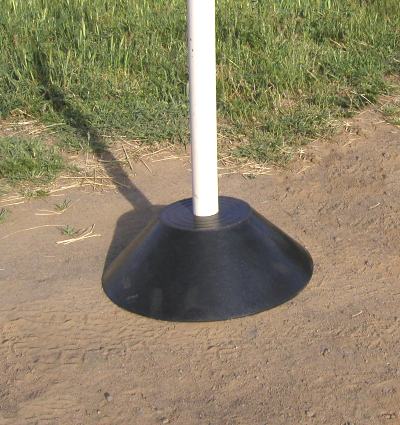
O'Neil base |
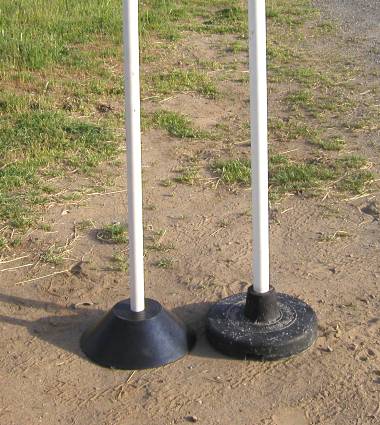
O'Neil base on the left, Compared to a Blackwood or Josey style base on the right. |
These bases are cone-shaped molded black hard solid rubber, made in the USA. Unlike the others, they are stiff but still flexible to the extent that if a horse were to step on one, there would be some give to it. They take a 1 1/4 inch PVC pipe, which is one size smaller than the others reviewed below, but this smaller size has no disadvantages. The bases are 14 inches in diameter, which is standard, they are 4 inches high, and weigh 8 pounds each. The base and pole weigh about half as much as the other brands of solid rubber bases, making them easy for a youngster to handle. We like to use the lighter 200 PSI PVC pipe with these bases because it keeps the weight down, but that light weight variety is getting hard to find. If you cannot find the lighter pipe, then the more common schedule 40 pipe works fine. We have seen these bases used at the AQHA World Show.
We like these bases. If we need to travel to an arena to work, these are the ones we take with us, because they are so much easier to handle.
Where can you get them? These bases have been hard to find, but they are readily available from Tom and Sherrie O'Neil in Ft. Lupton, Colorado. Contact them at 303-659-5786, or via EMail at: . Their web site with pricing information is available here >> (opens in a new window).
Josey Bases.
The hard rubber Josey bases can be considered comparable to the Blackwood bases above. The Josey web site says each base is a solid piece of durable, heavy rubber - they do not have to be filled with sand. But be careful! In the past you could find the Josey name on hollow plastic bases. The solid Josey bases we have owned were made of very firm solid rubber, with very little give to them. They are somewhat softer than the Blackwoods, but they cannot be bent or squashed. Each base weighs about 15 pounds, and are the standard 14 inches in diameter. They take a 1 1/2 inch PVC pipe. Each base and pole weighs about twice as much as the O'Neil bases described previously.
You can buy these good hard rubber bases directly from the Josey web site.
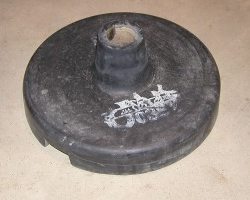
Josey solid rubber base - top. |
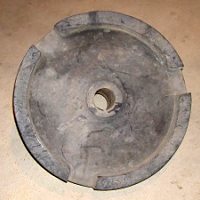
Josey solid rubber base, bottom. |
Blackwood Bases.
These bases were the old stand-by in pole bending contests across the nation. They are made in Spain of very firm solid rubber, with virtually no give to them. They cannot be bent or squashed. Each base weighs about 15 pounds, and are the standard 14 inches in diameter. They take a 1 1/2 inch PVC pipe. Each base and pole weighs about twice as much as the O'Neil bases described previously. We frequently encounter these bases in pole bending competitions.
You need to know that Blackwood bases can crack at the throat of the pole socket due to ice damage because they have no drain hole at the bottom. This problem can be avoided by cutting a drain hole in the center of the base. If you would like to see how we go about cutting the holes in these bases, look here >>.
We can no longer locate a source for these bases. For people looking for the regulation weight bases, we recommend you purchase the Josey bases. They are being used by the NPBA (National Pole Bending Association) at their National Championship Show. They are the same size and weight as the Blackwoods, and the rubber is better and a little more flexible. Our local saddle club has two sets of the Josey bases and they are working great for us. Get them directly from Joseys (see the previous Josey information).

O'Neil base on the left, Blackwood base on the right. |
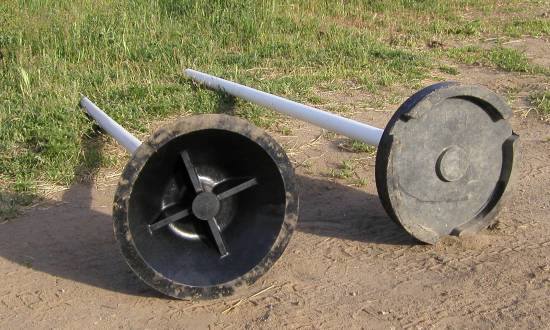
O'Neil base on the left, Blackwood base on the right. |
High Country Plastics Bases.
Okay, now let's discuss those hollow plastic models. We're referring to those that are designed to be filled with cement or sand, and when filled they mimic the more conventional Blackwood or Josey bases.
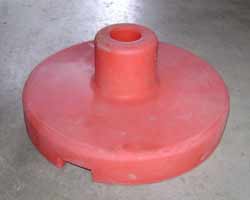
High Country pole base - top. |
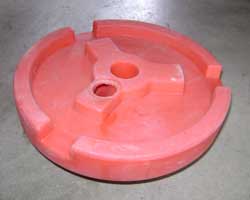
High Country pole base - bottom. |
What's good about them? They are the least expensive of all the alternatives, and because they are hollow, you don't have to pay to ship all the weight - you add the weight yourself after they arrive. Like the Blackwood bases described previously, they cannot be bent or squashed. When completely filled with sand, they will be safe and will serve you well. We have seen these bases in use at the prestigious All American Quarter Horse Congress. Each filled base weighs about 12 to 13 pounds, and they are the standard 14 inches in diameter. They take a 1 1/2 inch PVC pipe. They are in between the weights of the O'Neil and Blackwood bases.
Is there a negative about them? Yes - you must properly fill them and plug them!
If you fill them with cement, you will not have to worry about the plugs, but that option is not convenient for most people.
So ... let's assume you are going to fill them with sand. Here's how to do it successfully:
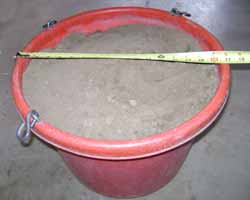
This stall bucket, 17 inches across and 12 inches deep,
holds more than enough sand for the job.
One of the many places you can buy these hollow plastic bases is from the Valley Vet Supply web site.
Now here's the key to success - Don't use the cheap plastic plugs that come with the bases! The plugs that come with the bases are virtually worthless, as they easily become loose and are lost, so you are going to have to get replacement plugs. Our advice is - Don't buy the bases until you have the replacement plugs in your hands. If you don't fill these bases, they will be way too light, and will tip at the slightest touch or breeze. Special thanks to our pole bending friends in Colorado, David and Becky Jo Hale, for sharing this solution.
There may be other plugs that work, but this one works really well. It is a Behlen Gate Plastic Cap plug - part# 1448107. There are different sizes - you want the 1 5/8 inch size. You can see from the photo that it has fins that hold it in place. Find your local Behlen fencing dealer and see if they stock them. If not, you can order them directly from the Behlen Country web site.
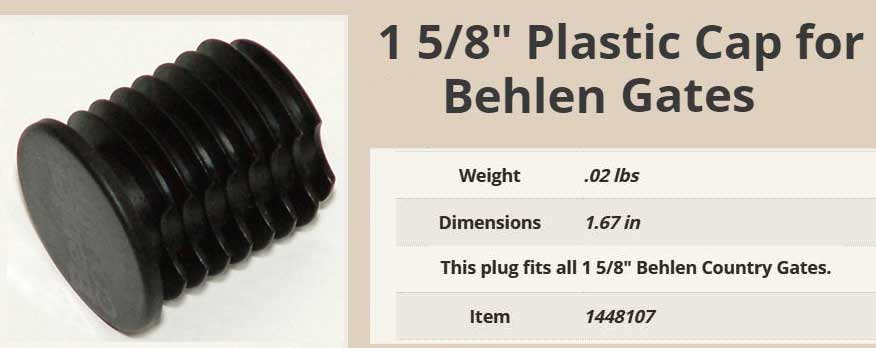
Behlen Gate Plastic Cap plug - part# 1448107
If you found this information via a search and you have not yet seen our Horsemanship and Pole Bending section, we would like to encourage you to take a look.
Ken and Pat Smith
Sunrise West Quarter Horses, LLC
2240 4th Avenue
Clarkston, Washington 99403
509-780-9614
All content in this document copyright © Sunrise West Quarter Horses, LLC, all rights reserved.

